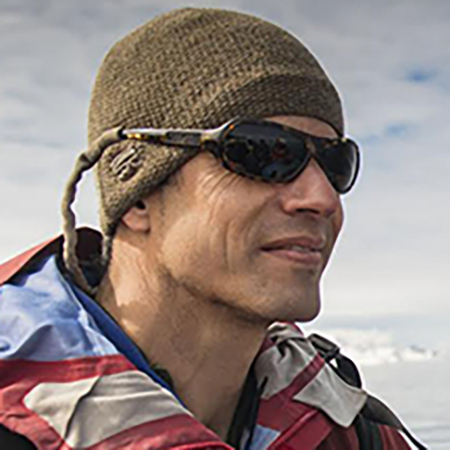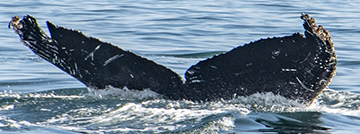“A Whale of a Tale” as Told by Ted Cheeseman
Do you know that every whale has distinctive markings on its tail?
Do you know that scientists are using these unique markings to track whales?
Do you know that in the 20th century, 3 million whales were killed by people?
Do you know what dangers whales are currently facing?
Recently, Ted Cheeseman, co-founder of happywhale.com, gave detailed answers to these thought-provoking questions at a speech held at the Bay Model Center in Sausalito in August 2018. With slide after slide, Ted showed the audience images of whale tails, each possessing unique features that can be used like ″fingerprints″ to identify each whale. Those images were uploaded to the website by citizen scientists from around the world. As Ted pointed out, the markings on each whale′s tail are caused either by nature (such as the whale′s own skin condition), wounds from killer whale attacks, barnacle formations, hazards created by mankind (such as ship strikes or finishing nets), or by any combination of these.
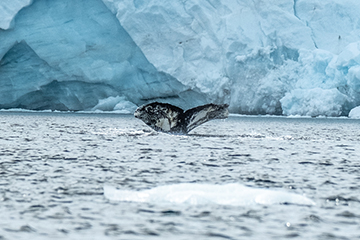
With the image processing capability of modern technology, scientists can now track individual whales by using the unique features on their tails in order to follow their migrations, allowing for better understanding of their habits and behaviors. Since there is a limited number of scientists to track the large quantity of whales that are constantly on the move, Ted decided to set up happywhale.com to invite the public to participate in the whale tracking. When an image of a whale′s tail is sent to the website, either a human or a machine tries to identify the whale. Once identified, photos of that particular whale from different locations are used to help map out the migration routes of that whale.
Since the inauguration of the website in 2015, it has processed over 114K photos, identified 31K encounters, and identified 16K individuals as of the end of August 2018.
Currently, Ted′s team can identify whales by the human eye with 90% accuracy; identification by machine is around 70% accurate. Ted hopes to increase the accuracy rate of machines to be on par with the human eye. With the help of Google and Kaggle, this goal might be accomplished in the near future.

Ted further mentioned that within the span of the past 100 years, the total population of whales has been reduced by 80-90% due to the booming whaling industry of the last century. In light of this daunting fact, Ted set up his site with the intention of tracking the remaining whales, especially humpback whales, and documenting their migration routes so that humans can monitor their well being and help the population recover.
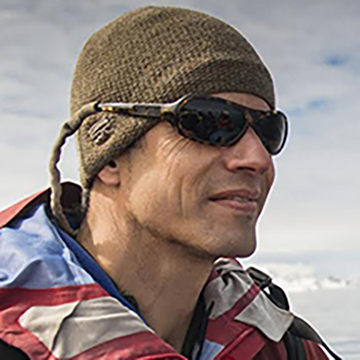
Ted is no stranger to wildlife. He has been traveling and photographing wildlife since he was a child. For two decades, he has been leading expeditions to remote parts of the world — Cheesemans′ Ecology Safaris — which was founded by his father and mother almost 40 years ago.
″Why whales?″ was my question to Ted when I had a chance to interview him a few days after his informative and yet touching speech. His answer made reference to an unforgettable experience related to his first encounter with what was then, 25 years ago, a very rare whale in Antarctica. Although the number of whales coming to Antarctica has increased quite a lot over the ensuing years, he still vividly remembers that one whale encounter. He felt he could do more for the whales than just taking photos of them and hanging the photos on the wall.

His desires to help whales became especially strong after a whale named Scarlett, a humpback whale, was photographed in August 2016 off Newport Beach, CA. She was tangled in a fishing line which wrapped around her pectoral fin and stuck in her mouth. This photo caused an uproar and increased attention from the public. People were relieved when Scarlet finally managed to escape from the fishing gear after much struggling. A few months after escaping the net, however, Scarlet was found dead in the ocean due to a failing health condition caused by the entanglement; her dark flanks had turned bright crimson due to a lice infestation. The story of Scarlett′s brave struggle and her tragic death caught the attention of many people. Ted felt those photos spoke ″a thousand words″ and proved to be an important tool to raise people′s awareness of the man-made dangers whales are facing every day in the ocean.
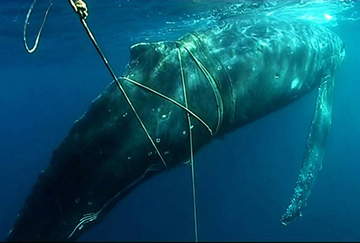
Of those dangers, the most life-threatening for whales are ship strikes and fishing line entanglements. Most of the fishing lines are unbreakable and, when attached to crab pots, can create thousands of pounds of drag. When a whale hits the line, it tends to turn and make a knot which is hard to remove. Imagine a whale caught in such a way! Imagine ourselves similarly entangled with no hands or tools of any kind to remove the line! In 2016, there were 71 reported incidents of whale entanglements in fishing lines on the US West coast alone, and this estimate represents just 10% of the total number of such incidents. ′There is so much scarring on the whales′, lamented Ted. He wishes his site can serve as a bridge to the public, to help people get engaged in the lives of whales and learn to respect and protect them in the ocean.
After the interview with Ted, I started pondering the overall impact we, mankind, have had on the whales. At one time, over a span of a single century, an industry systematically hunted and killed nearly 3 million of these peaceful creatures. Now we have scientists like Ted who are taking on the monumental task of trying to bring the number of whales back up. There is never enough to increase public awareness and to support their efforts. I hope more and more of us can lend our support and resources to help Ted fulfill his mission.
Ted′s Website
